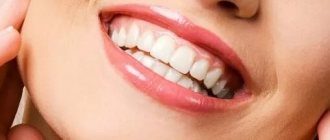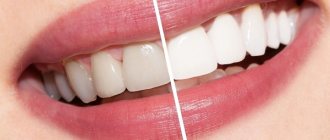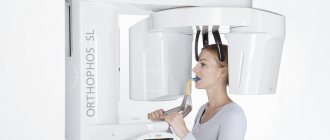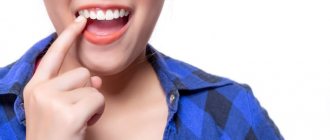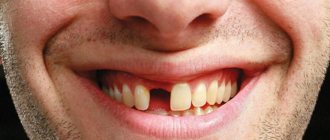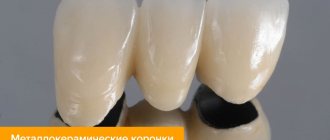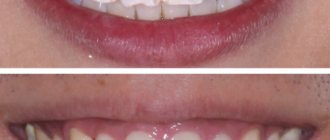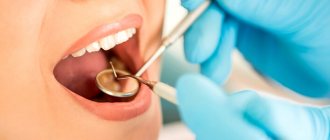How do covering dentures differ from removable dentures?
It’s easy to get confused in the concepts here, so let’s clarify that both types are removable. At least, that is what is commonly believed.
But in the classical view, coverings always have a strong support - teeth or implants. And traditional removable ones, especially with complete edentia, are fixed only on the gums. Although it is worth noting that in fact, even ordinary removable dentures have recently begun to be called overlays - this is argued by the fact that such structures also cover. Just not teeth or implants, but gums.
DENTAL PROSTHESIS ON 4 IMPLANTS - from RUR 170,000.
The price includes all procedures for installing Osstem implants (South Korea), including anesthesia and diagnostics.
Hurry up to sign up for a free consultation and fix your prices.
Call now or request a call
Opening hours: 24 hours a day - seven days a week
Price of covering dentures
The cost of a covering prosthesis largely depends on the treatment concept, design and material from which it is made. If we are talking about complete removable dentures, then the price for them starts from 15,000 rubles: for this amount you will get a regular plastic denture. If we are talking about nylon prostheses or products made of acrylic-free plastic, then the cost can easily reach up to 50,000 rubles for a full covering prosthesis (for example, AcryFree). Implant-supported overdentures will be even more expensive, especially if they are bar-retained. The cost here ranges from 60,000 to 100,000 rubles and also depends on the level of the clinic where the treatment takes place.
Covering dentures with fixation on the gums
This is the most famous and simplest type - the prosthesis is indicated for complete edentia (complete absence of teeth) and is attached only to the gums due to the “suction cup” effect. Such removable orthopedic structures take up a lot of space in the oral cavity - due to the massive artificial gum on the lower jaw and the palatal overlap on the upper jaw. Otherwise, they simply won't be able to resist.
Among the advantages are the lowest cost, almost complete absence of contraindications. The disadvantages are the following:
- very low comfort: nausea, gum chafing, blocked taste buds,
- poor fixation: displacement and falling out of the mouth, so there is a need to use a special “glue”, which does not always help,
- need for adjustments due to bone atrophy.
Bone atrophy deserves special mention. Areas of the jaw where there are no longer roots remain “idle.” And the bone, which does not receive chewing pressure, begins to atrophy (reduce in size in width and height). As a result, the gingival level decreases, and after a few months the removable “jaw” becomes uncomfortable - you will have to visit an orthopedist and have the structure repositioned.
Options include plate acrylic, Acry-free, nylon, polyurethane, Quattro Ti. You can read more about each variety by following the links.
Prices for complete prosthetics
| Name | Price, rub) |
| Complete jaw prosthetics on 4 Osstem implants (South Korea) with a fixed plastic prosthesis | RUB 225,000 |
| Complete jaw prosthetics on 6 Osstem implants (South Korea) with a fixed plastic prosthesis | 275,000 rub. |
| Promotion! Jaw prosthetics on 4 Straumann (Switzerland) or Nobel (USA/Sweden) implants with a fixed plastic prosthesis | 260,000 rub. |
| Promotion! Jaw prosthetics on 6 Straumann (Switzerland) or Nobel (USA/Sweden) implants with a fixed plastic prosthesis | 320,000 rub. |
Removable prosthetics
At the Family Dentistry clinic, treatment of patients with complete absence of teeth in the upper or lower jaw is carried out only by the method of permanent prosthetics on implants. The main disadvantage of removable dentures is atrophy of the jaw bone. The longer you wear them, the more bone tissue decreases. Subsequently, when the patient decides to install a fixed prosthesis, preliminary bone grafting will be required. If you decide to wear a removable denture, we can only help you find a good dental clinic that provides removable denture services.
1 Acrylic prosthesis
2 Acry Free dentures
3 Nylon prosthesis
A classic option for restoring the integrity of the dentition with complete edentia. In demand due to its low price. But at the same time it is the most inconvenient type of complete removable denture. Pros:
- low price;
- fast production times;
- easy to repair, adaptable (increases service life).
Minuses:
- provokes injury and inflammation of the gums due to constant stress;
- takes up a lot of space in the mouth (more voluminous than its counterparts), it is difficult for the patient to get used to wearing a plastic prosthesis;
- may cause an allergic reaction as a result of the free monomer contained in acrylic reacting with saliva;
- the artificial gum is opaque, the acrylic prosthesis does not look natural;
- Acrylic absorbs food coloring pigments and requires careful care.
Acry Free thermoplastic plate prosthesis is the most durable, aesthetic and long-term solution in complete removable prosthetics. Pros:
- The Akri Free prosthesis is thin and fits more tightly to the tissues of the prosthetic bed (the patient gets used to wearing it faster);
- does not cause allergies, as it does not contain methyl methacrylate;
- thanks to the aesthetic artificial gum, it is practically indistinguishable from your own teeth;
- has no pores (unlike acrylic and nylon), does not absorb food pigments, does not cause bad breath, and is less demanding in care;
- easy and inexpensive to repair.
Minuses:
- fragile, does not always withstand increased chewing loads and breaks;
- the price is twice as high as for an acrylic prosthesis.
Made from dental nylon, which is lightweight and elastic. Typically used as a temporary solution. Pros:
- takes up less space in the mouth, weighs less, so it is comfortable to wear;
- the prosthesis is flexible, easy to remove and put on, and will not break if accidentally dropped on the floor;
- The orthopedic design is practically invisible, as it is made of translucent material with a shade close to the color of the gums.
- does not cause allergic reactions like acrylic prosthesis.
Minuses:
- due to flexibility, it does not distribute the chewing load over the entire mucosa and leads to rapid atrophy of the alveolar ridge;
- nylon cannot be polished; after 2 years, plaque and pigments accumulate on it, and its attractiveness is lost;
- Eating hot food/drinks increases the elasticity of the prosthesis; frequent adjustments are required;
- rubs the gum, causing its atrophy (abrasions and bedsores form under the denture);
- repair of a nylon removable denture is very complex and expensive, and relining in the oral cavity is impossible;
- absorbs odors, after 1-2 years it begins to smell unpleasant.
Overdentures fixed to dental implants
Complete removable dental dentures require reliable and comfortable fixation, which is impossible if the structure is simply “sucked” to the gums. To do this, implants are installed on the dentition. The optimal quantity is 4 pieces for the upper jaw (here the bone is less dense) and 3-4 for the lower jaw. Some dentists install only 2 implants, but this number is not enough, because... the prosthesis does not hold very securely on them, and the implants are overloaded.
Implantologists recommend not placing all implants only in the anterior part of the jaw, if possible, but also using the lateral areas. This is optimal both from the point of view of distribution of the chewing load and the preservation of bone in the lateral areas.
PROSTHETIC PROSTHETICS WITH 4 STRAUMANN IMPLANTS “teeth in 1 day” - RUB 220,000. until January 15, 2022!
Complex implantation using ProArch technology (Switzerland) with immediate loading on the day of surgery!
Call now or request a call
A removable overdenture can be fixed to implants in different ways - on a spherical mount, on an equatorial type mount (Locator), on a beam. The covering orthopedic structure on implants is quite stable and it is not necessary to remove it every day. Therefore, dentists classify it not just as removable, but as conditionally removable prosthetics. Next, we will look in more detail at fixation methods.
"Push-button" fastening
On ball-shaped abutments
Ball mount is considered the simplest and most inexpensive option. In this case, in order to fix the overlay prosthesis, you need to place abutments on the implants (these are a kind of “adapters”) with a ball-shaped top. Special recesses are made in the prosthetic structure - matrices equipped with metal holders and silicone rings - when the patient installs the prosthesis, the matrix snaps onto the ball.
On equatorial type abutments
Equator-type or Locator abutments are also snapped into a silicone matrix, which is placed on the inside of the prosthetic base. However, the tops of the abutments are already presented in the form of cylinders with a seal on top, rather than balls. Therefore, their wear period, and, accordingly, their service life is longer.
As a rule, removable dentures on spherical and equatorial abutments are considered temporary options when the patient currently does not have the opportunity to undergo full implantation with fixed prosthetics.
Fixation on beam
A metal beam is the optimal way to fix a removable prosthetic structure on implants, because The chewing load is best distributed along the beam, which will then go to the implants and the jaw bone. The beam can be made by soldering or casting, but it is best milled using CAD/CAM systems (it is the most accurate). It is attached on top of the implants, uniting them like a bridge. And then a partial or full covering prosthesis is snapped onto the beam - there are special fasteners at its base, exactly in the shape of the beam.
Separately, it is worth highlighting non-removable dentures on implants - which the patient cannot remove on his own. Because they are fixed to the implants with small screws. But from the dentist’s point of view, this type will be conditionally removable, because The doctor himself can safely and quickly unscrew the screws and remove the structure - for example, for cleaning or repair. And then install it back. Such prosthetics are used with the very popular All-on-4 implantation technique.
Types of overdentures
The classification of overdentures is based on a number of characteristics. First of all, this is the design of the prosthesis. Experts distinguish two types.
- Partial overdenture.
It is used to replace a lost fragment of dentition on both sides of the jaw. Theoretically, a butterfly prosthesis can also be called a covering prosthesis, but most experts mean by this term a prosthesis that covers almost the entire area of the jaw. That is, even a partial overdenture replaces areas of the dentition on both sides of the jaw. - Complete overdenture.
The installation of such a prosthesis means that the patient has lost absolutely all his teeth. A complete denture has a more massive soft base, since there is no possibility of attachment to the patient’s natural teeth. There are only two options left: fixation with suction cups or implants.
Covering dentures with fixation on your teeth
When several natural teeth are preserved, a removable overdenture is fixed on their crowns or roots. After examining the oral cavity, the dentist may suggest one of the following mounting options:
- on clasps or hooks that cover the supporting teeth on the sides without covering them completely. For example, an “immediate butterfly” for 1-2 teeth, a clasp with clasps, as well as those already mentioned above (for fixation on the gums) can also be equipped with clasps,
- on spherical attachments: attachments are locking fasteners and are installed on the tooth root. The upper part of the attachment is usually presented in the form of a miniature ball onto which the inner part of the covering prosthesis is fixed. The second part of the lock is located in the prosthetic base. Such fastening, for example, is found in a sandwich prosthesis,
- on telescopic crowns: the fastening is similar to the previous type, but here an artificial one is installed on the root or remains of your own crown - and a slightly larger crown is installed in the prosthesis. The two elements fit very tightly onto each other, so the structure can not be removed for several weeks. But in production, this type requires a very highly qualified dentist so that the crowns fit perfectly together.
Read on the topic: how telescopic crowns increase the comfort of life after prosthetics.
Cover prosthesis - what does it mean?
Overlay (plate, removable) dentures are products that have a soft base that imitates part of the oral mucosa, and artificial teeth. There are quite a few varieties, but they are all removable, that is, the patient can independently remove them and install them back. Such dentures are often popularly called false jaws. This is partly true: those same teeth in a glass that appear so often in movies and TV series are also overdentures. Moreover, today removable overdentures are often placed on implants, which gives this orthopedic product a completely different status. Due to their versatility, overdentures have a significant list of indications.
Advantages of structures with fixation on roots or implants
The advantages of overlay prosthetic structures supported by teeth or implants are as follows:
- more reliable fixation in the oral cavity in comparison with classic removable ones, which are fixed only on the gums: attachment to remaining teeth or implants provides better stability and distribution of chewing pressure,
- do not rub gums,
- They are relatively small in size due to the absence of a massive palate or areas of artificial gum: therefore, the patient gets used to them faster, does not experience great difficulties with taste perception, and does not feel nausea,
- no need to use special adhesive creams,
- there is no need to build up the jaw bone before installing implants,
- pretty good aesthetics
- restoration of chewing function.
The advantages of covering structures “on buttons” are the low cost of tooth restoration. Implantation is low-traumatic - since mini-implants are often used. Also, the dental technician can modify the old overdenture for fixation on ball-shaped abutments, and the patient can continue to wear it.
Manufacturing procedure and materials
The production of a covering prosthesis takes place in several stages. In general, the entire process takes less time when compared with classic prosthetics.
✔
Consultation, examination of the oral cavity, radiographic examination.
✔
The choice of orthopedic design depends on the clinical case and the wishes of the patient.
✔
Taking impressions.
✔
Making plaster and wax models taking into account anatomical features and bite.
✔
Making the base of the prosthesis.
✔
Fixation of artificial teeth.
✔
Processing and polishing of the prosthesis.
✔
Installation of a covering prosthesis.
Much depends on the material of the prosthesis. Currently, overdentures are made from acrylic plastic, acrylic-free plastic and nylon. Plastic is a durable material that copes well with the chewing load, but it can injure the mucous membrane and cause allergies due to the presence of harmful monomers in the composition. Nylon dentures are soft, comfortable and very aesthetic, but are not suitable for installation on a completely toothless jaw, since they do not have sufficient rigidity for comfortable chewing. One of the best options is a prosthesis made of acrylic-free plastic, which has the required rigidity, but is also safe for soft tissues.
- Restoration of chewing function (with implantation - almost in full).
- Not bad aesthetics.
- Fast production times.
- The ability to independently remove and clean the prosthesis.
- Affordable price (if we are not talking about a prosthesis on implants).
- The overdenture itself is unable to completely restore the functionality of the teeth and stop bone tissue atrophy.
- Requires careful care.
- Limited service life (from 3 to 7 years depending on the material).
Disadvantages of structures with fixation on roots or implants
Coverings that rely on natural roots always run the risk of overloading or poor-quality preparation of supporting teeth for prosthetics. Therefore, after 5-7 years they often have to be removed.
“About a year after the prosthetics, my artificial jaw began to wobble a little. The dentist said that this is due to the fact that the load is large and the bone is dissolving around the roots. In general, as I understand, everything will only get worse, and the roots will have to be removed in a few years. In the meantime, the doctor advised us to strengthen our hygiene and try not to chew hard.”
Maria Vasilievna, review from the site irecommend.ru
The disadvantages of conditionally removable prosthetics on implants include the short service life of mini-implants (about 3 years). Disadvantages of beam fastening - it is impossible to adapt an old orthopedic design, and the cost of this solution is close to implantation on classical implants (which last for several decades) with the most reliable fixed prosthetics.
Stages of prosthetics
Before installing an overdenture, the gums are prepared and periodontal pockets or part of the mucous membranes are removed. The whole process can be divided into the following stages:
- performing a thorough examination of the oral cavity;
- treatment of teeth and gums;
- selection of the most suitable, taking into account the individual situation of the patient, dental prosthetic structures and fastening connections;
- if natural teeth are used as support, they are prepared for the procedure and implantation is performed;
- temporary crowns are installed during the healing period of the implants;
- impressions are taken, a model of the covering prosthesis is created;
- The design is tried on, adjusted, and then secured for permanent wear.
After performing the procedure, the patient must properly care for the structure, which will prevent its rapid wear or breakage.
Materials for the manufacture of structures
Now dentists have an impressive arsenal for the manufacture of all types of orthopedic structures. Covers can be made from the following materials:
- for the manufacture of artificial gums and prosthetic bases, acrylic is used (can cause irritation of mucous membranes), hypoallergenic monomer-free Acry-free, durable acrylic reinforced with diamond chips, polyurethane, nylon (very flexible and aesthetic, but stretches over time and cannot be repaired), Dental D" for Quattro Ti,
- metal and silicone are used for fastening elements: the most popular metal alloy is medical steel, but cobalt-chromium alloy (CHS), titanium,
- for artificial teeth: it can be acrylic, ceramics, metal-ceramics, metal-plastic, as well as zirconium dioxide (the most durable, but also the most expensive material).
Indications and contraindications
Indications for prosthetics are as follows:
- severe wear of natural crowns,
- complete destruction of the crowns, provided there are healthy roots (at least two of them must remain),
- the absence of many or all teeth in a row.
Contraindications to prosthetics on your own teeth are their mobility, the presence of cysts, granulomas, cracks and inflammation in the roots (the latter defect can be eliminated).
Contraindications to implantation are decompensated diabetes mellitus, serious pathologies of the endocrine cardiovascular system, recent heart attack, radiation or chemotherapy.
It is also impossible to install a prosthetic structure (removable or fixed) simultaneously on an implant and a natural tooth, because the latter has micromobility, but the implant does not.
Contraindications
In some cases, installation of overdentures is not possible. Diseases for which overdentures are contraindicated include the following diagnoses:
- Thyroid diseases;
- Severe diabetes mellitus;
- Blood diseases;
- Pregnancy;
- Oncological diseases.
Before the procedure, the patient must undergo an examination, which includes a number of studies aimed at identifying the above diseases.
What stages are included in prosthetics?
- Stage 1 – diagnosis: before implantation, tests are taken and a computed tomography scan of the jaw is performed. In other cases, doctors often make do with a targeted image, but CT is more informative,
- stage 2 – sanitation of the oral cavity: caries and pulpitis are treated here, the remaining roots are prepared, and ultrasonic air-abrasive cleaning is carried out. If necessary, the dentist cleans the gum pockets from pathological contents (this is called curettage). Also at this stage, you can do gingivotomy or gum surgery, frenuloplasty, remove diseased teeth,
- stage 3 – taking impressions and other parameters to create a model,
- stage 4 – implantation (if necessary): here the required number of implants is implanted,
- stage 5 – fitting and modification of the prosthesis,
- Stage 6 – final fixation of the finished product and training the patient in the rules of care.
Don't know what type of prosthetics to choose?
We will help in the selection, advise where to read more information and compare types of prosthetics.
Consultation with an orthopedic doctor in Moscow clinics is free! Call now or request a call
Working hours: from 9:00 to 21:00 - seven days a week
Features of using BPS technology
Let's first understand what BPS is? This is a biofunctional prosthetic system or Biofunctional Prosthetic System. Its meaning is that before making an overdenture, the parameters are taken using special devices to create an ideal bite and the relationship between the teeth on the upper and lower jaw. In the process of creating an orthopedic structure, an articulator, a face bow, and a Centric Tray impression tray from Ivoclar Vivadent are used. Several impressions are taken from the dentition, and parameters are assessed with the jaws closed and open. Also, the design model is tried on several times.
As a result, a product that is almost ideal in terms of comfort is created, which the patient practically does not feel in the mouth. The work of the temporomandibular joint is also normalized, the smile looks natural, and the face as a whole is harmonious.
Advantages of dental implantation and prosthetics at the Vivadent clinic
The Vivadent dental clinic specializes in dental prosthetics and uses the most modern and high-quality materials for manufacturing. Thanks to this, we guarantee a long service life, high quality and ease of use.
Our specialists are constantly improving and studying new methods of dental prosthetics. That's why we offer the most advanced ways to preserve your smile and natural appearance even in the most difficult cases. Modern equipment, highly qualified specialists, comfortable conditions, painless treatment at affordable prices - you will find all this in our clinic. We value our reputation as one of the best clinics that specialize in prosthetics, therefore we offer our patients the most favorable conditions.
Covering dentures in the case of complete absence of teeth is the only way to return to a full lifestyle, restore an attractive appearance to your smile, and the ability to eat any food. After just a few days, the patient completely gets used to the new jaw and does not feel any discomfort. This is a great opportunity to regain self-confidence and become a successful person.
The Vivadent clinic is the best choice for preserving a beautiful smile! For regular customers there is a flexible system of discounts. You can get acquainted with promotions and conditions for providing discounts on dental treatment and prosthetics services using modern and high-quality materials on our website or from the clinic administrators. Our clinic doors are open every day, including weekends and holidays.
Care instructions
Caring for overdentures on implants or on your own teeth is not much different - after eating, rinse your mouth with clean warm water or mouthwash. You can also use an irrigator, which very efficiently washes out food debris from the subprosthetic space. You need to brush your new teeth 2-3 times a day - it is better to buy a new brush, with soft bristles, and the toothpaste should not contain scratching abrasive particles.
For better cleansing, every 2-3 weeks you need to remove the orthopedic structure from your mouth - clean it from all sides, soak it in a special disinfectant solution. You should visit your dentist every 6 months for a check-up and professional cleaning.
Advantages and disadvantages
Advantages:
- due to the redistribution of pressure on the supporting teeth, such structures are characterized by increased functional activity;
- used for atrophy of the alveolar ridges;
- reduce the degree of pressure on the mucous membrane;
- there is no need for additional bone tissue augmentation;
- a covering prosthesis installed on the upper jaw reduces the limits of the base of the structure;
- have a shorter adaptation period;
- are an ideal option for people suffering from an increased gag reflex;
- can be used at the transitional stage before installing a complete removable denture;
- They are distinguished by comfortable wearing, reliable self-fixation, biological inertness and aesthetics.
Flaws:
- high cost, which is calculated individually in each specific case;
- If they are installed on natural teeth, then the patient will require careful care of the overdentures and more effort to maintain their functional state.
Cost of covering orthopedic structures
Prices for overdentures vary greatly depending on the material, complexity of the work, and the need to install implants.
The most budget-friendly solution is made of acrylic with clasps, it costs about 15-20 thousand rubles for the restoration of one jaw. “Butterfly” costs from 6,500 rubles, clasp - from 40 thousand. Prosthetics on implants starts from 100 thousand - on spherical attachments, from 120 thousand rubles when fixed to a beam. And from 200 thousand, if the prosthesis is fixed with screws or cement, that is, it becomes irremovable. 1Zagorsky V.A. Partial removable and overlapping dentures, 2007.
Features of installing a prosthesis on implants
The overdenture is installed on two, four or six implants. The most reliable way is to install on four artificial roots. A removable structure cannot be installed on one side - on your own tooth, and on the other - on an implant, since the mobility will be different and the load will be distributed unevenly.
Removable integumentary prosthetics on an implant with a push-button locking fastening. According to this technique, spherical attachments are fixed to the implanted artificial roots. In this case, the prosthesis is made with a special mechanism. When installed on attachments, the structure is securely fastened. This technique is also called “ball”; it is the most popular and is indicated in almost all cases.
Removable integumentary prosthetics on an implant with a beam locking fastening. The installation technology is more reliable, but also more complex to implement. After the implants are integrated into the bone, a metal beam is fixed between them. On the inside of the removable denture, the dental technician makes a recess corresponding to the size of the beam, and inserts a silicone matrix into it, which will tightly fit the metal beam. As a result, the mount is durable and reliable.
Treatment involves several stages depending on the condition of the oral cavity and the method of prosthetics:
- After the examination, the doctor takes impressions of the upper/lower jaw and sends them to a dental laboratory to create a plaster model of the future restoration system. During this period, the patient is put on a temporary plastic prosthesis.
- When installed on natural supporting teeth, the doctor grinds them down. In case of severe edentia, implantation is performed.
- After grinding the enamel of natural units or installing implants, the dentist makes a new impression to determine where the removable structure will be attached. Based on these impressions, a wax template is created, from which the dental technician makes the finished prosthesis.
- The product is tried on and adjusted. It should fit well on the jaw and cover the roof of the mouth tightly. If necessary, the technician adjusts the product for comfortable wearing.

